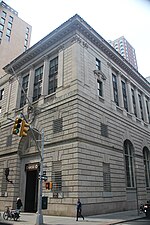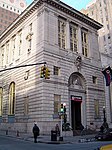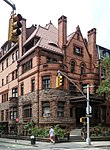First Unitarian Congregational Society
1833 establishments in New York (state)Brooklyn building and structure stubsChurches in BrooklynNew York City church stubsUnitarian Universalist churches in New York City

First Unitarian Congregational Society in Brooklyn is a Unitarian Universalist congregation in Brooklyn, NY. The Society was established in 1833 and has been worshiping in its historic Gothic Revival Sanctuary since 1844. The Sanctuary is adorned with stained glass windows and a Louis C. Tiffany angel mosaic. It is one of the earliest Unitarian congregations in the United States, established just 8 years after the American Unitarian Association was formed in 1825.
Excerpt from the Wikipedia article First Unitarian Congregational Society (License: CC BY-SA 3.0, Authors, Images).First Unitarian Congregational Society
Monroe Place, New York Brooklyn
Geographical coordinates (GPS) Address Phone number Website External links Nearby Places Show on map
Geographical coordinates (GPS)
| Latitude | Longitude |
|---|---|
| N 40.69529 ° | E -73.99282 ° |
Address
First Unitarian Universalist Congregational Society
Monroe Place 50
11201 New York, Brooklyn
New York, United States
Open on Google Maps








